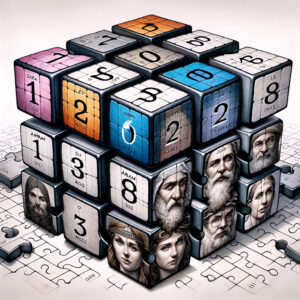The Mystery of When Kohath and Amram were born
In the Bible, significant individuals typically have both their births and deaths recorded. For those few where this information is missing, it serves two purposes:
- To present a riddle, which the Bible says is an honor to solve.
- To indicate multiple meaningful possibilities for their life spans or dates.
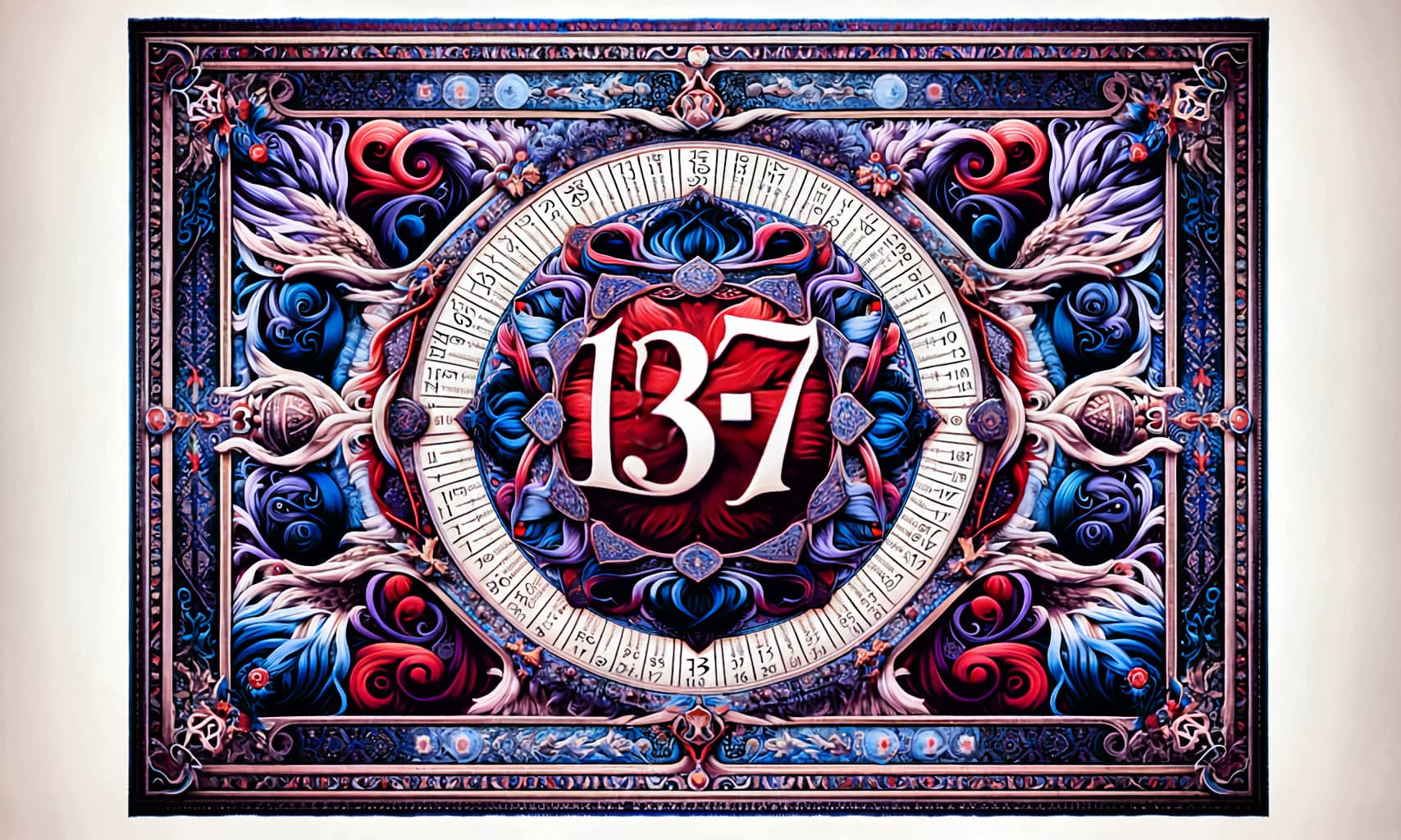
Numbers are not merely figures but threads weaving a story of redemption
This composition lays foundational insights to which I will frequently refer in future expositions. Think of it as a reference guide for concepts like ‘The 13/7 Redemptive Thread’ that I’ll mention later. This way, I won’t have to explain the same idea each time it comes up—I’ll just point you to this foundational piece. It’s a thorough exploration for those keen on deepening their grasp of the Scriptures.
Kohath and Amram are pivotal figures, establishing the family line from which all High Priests are descended. Their lives, much like Melchizedek’s, are shrouded in mystery as the Bible does not detail their births or deaths. Further in our study, we’ll explore how, just as Melchizedek is a figure of Christ in his eternal priesthood, Kohath and Amram represent the enduring priesthood of Christ within His people during times of struggle, symbolized here by ‘Egypt.’ As depicted in Revelation 1:5-6, this positions us as Christ’s priests in a dark world.
While Melchizedek symbolizes Christ’s eternal priesthood, Kohath and Amram represent how this priesthood is expressed through the Church, especially in this dark world, like a flame in clay jars: a living sacrifice. Melchizedek underscores Christ’s deity prior to the Incarnation, but Kohath and Amram focus on how His priesthood is manifested in the Church, the Body of Christ. This illustrates that Christ’s priestly ministry is ongoing and active within His people, initiated by the fiery presence of the Holy Spirit at Pentecost.
He (Melchizedek) is without father or mother or genealogy, having neither beginning of days nor end of life, but resembling the Son of God he continues a priest forever.
Hebrews 7:3 (Cf., Gen. 14)
See Bible.ca for a chart of the Levitical Priesthood by Steve Rudd
When the sun had set and darkness had fallen, a smoking firepot with a blazing torch appeared and passed between the pieces.
Genesis 15:17 (We’ll discuss this covenant later; refer to Gen. 14-15.)
To uncover the hidden birthdates of Kohath and Amram, we must understand the biblical pattern of numbers 7 and 13, which together weave a narrative of redemption. This exploration will situate Kohath and Amram within the genealogy from Adam to Moses, illuminating two generations that, while pivotal, remain enigmatic within the scriptural record. Analogous to the concealed fold in the Tabernacle’s entrance covering, described in Exodus 26:9, Kohath and Amram are integral to the lineage yet not immediately evident in the historical narrative. (Remarkably, the folded-back square area of the cloth is 1260 sq. cubits, Rev. 11:1-2.)
As the hidden fold at the doorway is essential to the integrity of the Tabernacle’s covering, so too are Kohath and Amram to the completion of the genealogical sequence, setting the stage for Aaron to enter and thus concluding the ancestral line from Adam to Moses. Accordingly, Kohath and Amram serve as the extension of Levi as revealed by the ‘Key of 23.’ Through Levi, Kohath, and Amram, a genealogical gateway is established for Moses and Aaron to emerge, symbolizing the living tabernacle that God has been architecting through generations. Thus, from Adam to Moses, we see the divine blueprint of a spiritual lineage, a testament to the meticulous and purposeful construction of a holy lineage, mirroring the spiritual edifice that Peter speaks of in his first epistle.
You yourselves like living stones are being built up as a spiritual house, to be a holy priesthood, to offer spiritual sacrifices acceptable to God through Jesus Christ.
1Peter 2:5
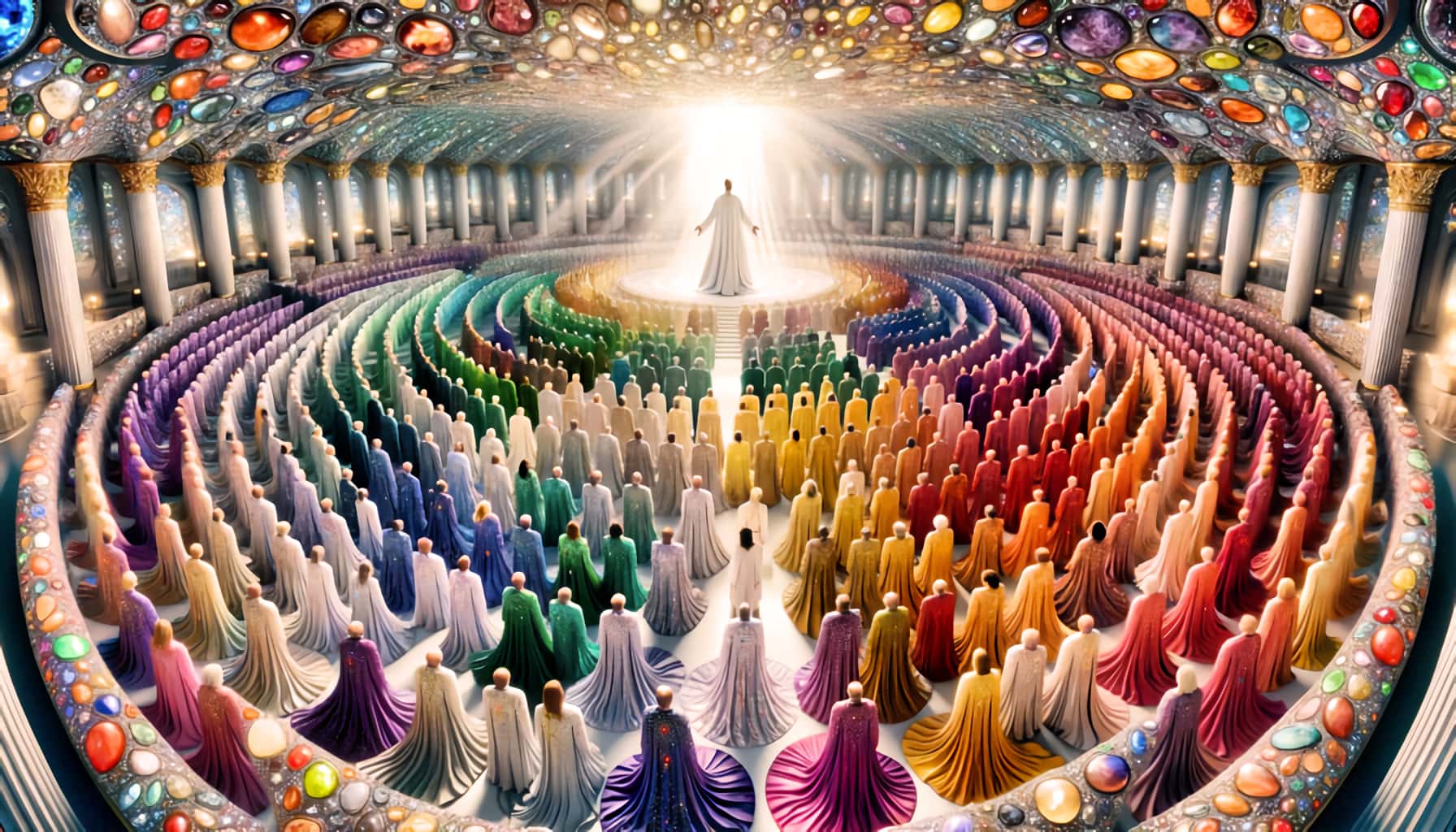
Kohath and Amram: A Fold in the Genealogical Tent at its Entrance
In the sacred genealogy, Jacob begets Levi, who in turn fathers Kohath. Kohath then fathers Amram, the progenitor of Aaron and Moses. As Enoch is the seventh from Adam, so Levi stands as the twenty-third, a number that prophetically extends to twenty-five, hinting at the concealed birthdates of Kohath and Amram in Egypt. The ‘Priestly Key of 23‘, which expands to twenty-five, aligns with the priestly year, bringing these two veiled generations to light. However, our immediate focus is on the ‘7/13 Redemptive Thread’—an understanding that fills gaps in biblical chronology and enriches our comprehension of Scripture’s redemptive patterns. This redemptive thread is like the rich tapestry embroidered within the Tabernacle of Moses.
Moreover, you shall make the tabernacle (sacred tent of worship) with ten [interior] curtains of fine twisted linen, and blue, purple, and scarlet fabric; you shall make them with [embroidered] cherubim, the handwork of a skillful craftsman.
Exodus 26:1 (AMP)
Aaron was gathered to his fathers half a year prior to Moses, which aligns with the understanding that Aaron was born 3.5 years earlier than Moses, a period referenced in Revelation 12. Scripture provides the precise timing in Exodus 7:7, Numbers 33:38, Deuteronomy 1:3, and 34:7. (Refer, “Chart of Deaths of Moses and Aaron.”) Consequently, the birth and death dates for patriarchs preceding Moses can be adjusted by half a year. This adjustment reveals a pattern not simply of ‘130 plus or minus 3 or 4 years’, but rather a more exact ‘130±3.5 years’.
This pattern of 130±3.5 years is noted in the lives of Terah, Sarah, Joseph, Levi, Kohath, Amram, and the pairing of Aaron with Moses. Yet, before we delve further into the chart that includes the dates for Kohath and Amram, it’s essential to acknowledge the presence of a redemptive thread, woven with the numbers 13 and 7, throughout the Biblical narrative. Exploring this thread is paramount, for it brings to light the 130±3.5-year cycle that determines the birth times of Kohath and Amram.
Examples in the Bible where 7 and 13 are combined to signify redemption
The pairing of the numbers 7 and 13 (or 7 with 130, etc.) in some combination conveys the concept of “Atonement” and thus, redemption.
- Seven is emblematic of completion.
- Thirteen (or 130) represents curse or imperfection.
Atonement” denotes a covering or a reversal. Within this structure, 7 balances or envelops 13, effectively countering its defects and reversing the curse. The 7/13 interplay has multiple layers, with the context in which this numerical pattern is woven into the Biblical narrative revealing its subtleties. For instance, 7 found in the Creation account, combined with 13, 130, or 1300 years, might represent the period during which the perfect creation has fallen under the curse. It also links Biblical narratives, for example, the Creation to the Flood.
In exploring these instances, we aim to enhance clarity, though a detailed exposition of each intricate variation will not be pursued currently. The reader is poised to appreciate the 7/13 nexus as a tapestry, richly intricate, diverse yet interwoven, depicting the numerical narrative of redemption from Adam to Christ.
If ‘seven’ signifies perfection, what does the dividing of seven mean?
The ‘dividing of seven’ often implies the violent action of ‘cutting’ a seven in half, which by extension refers to sacrifice—as illustrated in sacrificial rites and covenant-making ceremonies referenced in Daniel 9:24-27 and Genesis 15.
The Hebrew word ‘to swear’ is שבע ‘shava’ which is also related to the Hebrew word for the number 7 שבע ‘sheva’ and has the meaning of completeness or fulfilment. To swear then gives us the idea of doing it seven times for completion and ensures it is guaranteed.
הebraic הeritage
The Hebrew term בְּרִית bĕriyth for “covenant” is from a root with the sense of “cutting”, because pacts or covenants were made by passing between cut pieces of flesh of an animal sacrifice. There are two major types of covenants in the Hebrew Bible, including the obligatory type and the promissory type.
Wiki
He will confirm a covenant with many for one ‘seven.’ h In the middle of the ‘seven’ i he will put an end to sacrifice and offering. And at the temple j he will set up an abomination that causes desolation, until the end that is decreed is poured out on him.
Daniel 9:27
I’m not looking to get into the depths of this basic idea right now. What I want to point out is how the pattern of 7/130, and especially the sequence of 3.5+130+3.5 years, gives us clues about when Kohath and Amram were born.
Kohath and Amram are unique in the family line from Adam to Moses because we don’t have their exact birth dates. All we know is they lived when the Israelites were in Egypt. They were born, lived, and died within the 430 years that the Israelites were in Egypt, a time that’s come to symbolize both death and a kind of rebirth. It’s as if Israel itself ‘died’ in Egypt and was ‘reborn’ as a nation 430 years later. This is an interesting pattern to consider on its own.
Moses was born in 1526 BC, and by that time, the Israelites had been living in Egypt for 350 years since 1876 BC. This time frame is notable as it is exactly half of 700 years, mirroring the way that 3.5 is half of 7, further underscored by Aaron’s birth 3.5 years earlier. Seen as a deliverer, Moses faced a significant life event 40 years later. In an outburst of anger, he killed a man and was forced to flee Egypt in disgrace. This act of violence happened 390 years after the Israelites arrived in Egypt (130×3).
In this pattern of 7/13, we observe the interplay of numbers: 350, representing the years to Moses’s birth, symbolizes a sacrificial beginning as he was cast upon the Nile in a baby-sized ark, and 390 years, a triad of 130s, reflects Moses’s subsequent escape from Egypt in failure as detailed in Exodus 2:11-25. The other 350 years that complete the 700-year cycle are found in Noah, who lived for 350 years after the flood. His death, 350 years post-flood, coincides with Abraham’s birth. This mirrors the 350 years from when the Israelites entered Egypt, seeking salvation from famine, to the birth of Moses.
We’ll now turn back to Genesis and spotlight the 7/13 redemptive threads woven throughout the narrative leading to Christ before revisiting the four generations who dwelled in Egypt.
Examples of the Interplay of 7 and 130: The Scarlet Thread of Atonement
Feel free to bypass the dense caption below the image. The Redemption Tapestry’s details could unfold into a book, evidently crafted by an intelligent force. But which intelligence? Scholars across ages, perhaps in Babylonian captivity 2500 years ago, or divine influence exceeding human skill? Doubters are invited to verify each fact and then, through careful contemplation, judge the true source of this intricate work.
The patterns in the caption represent just half the narrative, which is fully realized when each date is mirrored with an “AD” counterpart—for instance, “4114 BC” for Creation aligns with AD 4114, and 1406 BC corresponds with AD 1406. This mirroring unveils the tapestry’s rich symmetrical design and, like a fractal, merges flawlessly with the “Long Chronology” (“14466 BC” to AD 1406), using the “Key of 23.”
Curiously, “1/137” holds scientific weight, mirroring facets of Creation.

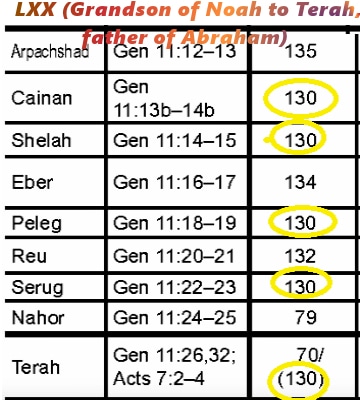
The pattern of 7+130, further broken down as 3.5+130+3.5, first appears during Creation. In the Bible, it’s common to represent a day as a year. Therefore, the seven days of Creation can be interpreted as seven years. Yet, the narrative of man’s transgression and the subsequent curse on the land is illustrated when Adam, at the age of 130, became the father of Seth (who stepped into the role left vacant by Abel after Cain’s act of murder).
Adam lived for another 800 years, culminating in a lifespan of 930 years. This falls short of the symbolic 1000 years by a margin of 70 years. The number 1000 is emblematic of a single day, as echoed in Genesis 3:19, “In the day that you eat…you shall die.” Hence, Adam’s life pattern can be described as 130+800+70, which equals 1000, with the numbers 130 and 70 framing the sequence like bookends.
Or take Cainan, who has his child at 70 and dies at 910 (70×13). (Cainan reappears in the LXX later, as seen in the table at left, who has a son at 130!)
How about Lamech, who has his son at 182 (7×13) and dies at 777.
Shem to Abraham and Isaac, we explain briefly in the above table. But observe Terah, whose +60 variation lifts his age when Abraham was born from 70 to 130.
Consider Jacob: At 77, he fled his vengeful brother, finding exile in Haran. By 130, he faced another exile in Egypt, where he died at 147 (7x7x3). His son Levi died 77 years after that.
The 7-13 pattern originates from the 4th day of Creation when the sun, moon, and stars were fashioned. This day, a Wednesday, serves as the week’s midpoint, effectively splitting the week into segments of 3+4 days or 3.5+3.5 days. The Enochian Calendar, steadfastly anchored to this Wednesday midpoint, consistently follows this division. It organizes its four seasons into periods of 13×7 days, culminating in an annual cycle of 364 days. Crafted to provide atonement throughout its seasonal transitions, the Enochian Calendar harmoniously navigates the enduring cosmic tension between the numbers 7 and 13, representing perfection and imperfection. For a comprehensive understanding, one can explore “The Enochian Calendar”.
We’ve previously touched upon the ‘910’ associated with Cainan and Lamech’s ‘182’, both representing Enochian partial years. Here, 182 is half of 364, while 910 is 2.5 times 364. Enoch, in his timeline, fathered a child at the age of “65”, ascended at 70 for “six jubilees,” lived up to ‘364’ years, lingered for “one more year,” and was ultimately taken at the age of “365”. This can be discerned by juxtaposing the Book of Genesis with the Book of Enoch and the Book of Jubilees.
The 7-13 pattern consistently weaves its way through the scriptural tapestry. Consider the conquest of Canaan: Jericho was circled once daily for six days, but on the seventh day, it was encircled seven times, culminating in 13 circuits (6 + 7 = 13). This intricate design is mirrored in the Book of Revelation, where the seventh seal ushers in seven trumpets, heralding the culmination of this age, as delineated in Rev. 4-11.
Or take Solomon as an example: Seven years he spent building the Lord’s house, but after that, he took a contrasting 13 years to build his palace.
Isaiah’s prophecy of 65 years (13×5) set the stage for the subsequent 70 years that Judah spent in exile (Isaiah 7:8).
Ezekiel, bearing Israel’s sins, underwent 390 days (equivalent to 130×3) of burden, preceded by “seven days overwhelmed,” as detailed in Ezekiel 1-4. Ezekiel ‘bore the sins of the house of Israel’ and foreshadowed Christ.
The 7/13 Redemption Thread Realized in Christ
The 7-13 pattern also underpins the well-known “1260+1260” days found in Daniel and Revelation, as well as the 2300 of Daniel 8. 1260+1260 equals seven years, each consisting of 360 days. But how does 2300 connect with 13?
Daniel prophesied the temple’s cleansing/righteousness after 2300 days (Dan 8:14). Both 1260 and 2300 are tethered to this theme and to Israel’s 40-year wilderness sojourn (Rev. 12). This is further associated with the law of purification for a male child—specified as “40 days” in Leviticus 12. A similar “40 days” of cleansing is evident during the Flood, as waters purged the earth’s corruption. Though we won’t delve deeply into this now, the key takeaway is associating the 2300 days of purification with the 40 days, equating to 40+2300=6.5×360 (or half-13×360).
This pattern becomes evident in Christ’s life, marked by a 40-day period depicted in the Gospels. Christ’s ministry, originally spanning 7×360 days, was curtailed to 3.5×360 (or 1260 days as per Rev. 11-12). This intersects with half of the 2300 days, broken down as: a 40-day wilderness temptation culminating in the seven days of Tabernacles, plus 1260 days leading to the week of Christ’s Passover crucifixion. Thus, 1150 days from Tabernacles coincides with the seven-day Feast of Lights/Dedication, observed by Jesus in the Gospel of John the winter preceding his crucifixion (John 10), now celebrated as Hanukkah. An additional 110 days brings us to Passover—where ‘110’ symbolically represents eternal life; hence, 1150+110=1260. Both the 1150 and 1260 durations were cut short of their full length, but when fully expressed, they form 40+1150+1150=6.5×360.
While there are myriad details in this significant pattern we won’t explore here, it’s essential to note that the 7/13 redemptive thread culminates in the birth, death, resurrection, and eventual ascension/Second Coming of Christ. We now anticipate the remaining 1150/1260 days to complete the pattern, marking Israel’s reintegration into its vine and the resurrection of the dead (Rom 8-10).
In observing the flow of this pattern, we see it moving both forward and backward in time, symbolically reversing the curse. Utilizing the 40 days Christ endured temptation in the Wilderness and the subsequent 40 days from His resurrection to His ascension, a distinct sequence emerges: 40+1260+40. This structure allows for a ‘1300’ span in any time direction, with the 70×18 (1260) in the middle. Intriguingly, this means that the significant “40”+110=”150″ day-markers present during Noah’s Flood find their realization in Christ.
It’s noteworthy that the 40-day Flood period in Noah’s time aligns with Hanukkah—even before Hanukkah was established (Gen. 7:4; 7:24). Following this, Christ’s ascension occurred on the anniversary of Noah’s exit from the ark. These patterns, deeply interwoven throughout history, ultimately point to Christ’s fulfillment. Christ is the Mystery of God, and figures like Kohath and Amram serve as anticipatory symbols, heralding our “Great High Priest” (Heb 4:14-16; cf., Heb 7:3).
What the engrafting of Kohath and Amram back into their geological tree symbolizes
The distinct instances of the 7/13 Thread of Redemption guide us to decipher the enigma of the missing birth dates for Kohath and Amram. It’s significant to note that they alone were born and ‘fell asleep’ in Egypt. They serve as an allegory for the Church up to our current time—specifically alluding to the mystery of the hidden dispensation of the Church age as highlighted in Eph. 3:1-13; Rom 16:24; Col 1:26, cf., Heb 7:3). Christ is our ‘Israel,’ who descended and ascended from ‘Egypt’ ahead of us, and is in us, as did Abraham ahead of Moses, (Gen 12).
This is further echoed in the solemn Covenant of the Pieces (Gen 15). Here, the Spirit of Christ, resembling fire, moved between the sacrificial pieces, with the Lord soberly declaring His unwavering presence with His people in Egypt’s darkness and His eventual deliverance of them “in the 4th generation”. In a parallel commitment, Christ assures the Church of His enduring presence, vowing ‘never to leave nor forsake us’ in this dark world.
8 But Abram said, “Sovereign Lord, how can I know that I will gain possession of it?”
9 So the Lord said to him, “Bring me a heifer, a goat and a ram, each three years old, along with a dove and a young pigeon.”
10 Abram brought all these to him, cut them in two and arranged the halves opposite each other; the birds, however, he did not cut in half…
17 When the sun had set and darkness had fallen, a smoking firepot with a blazing torch appeared and passed between the pieces. 18 On that day the Lord made a covenant with Abram and said, “To your descendants I give this land, from the Wadi of Egypt to the great river, the Euphrates—
Gen. 15 (2081 BC)
Gen. 46:4 I will go down to Egypt with you, and I will surely bring you back again. And Joseph’s own hand will close your eyes.” (1876 BC)
Kohath and Amram, in their symbolic roles, echo this promise. Their reintegration into the genealogical tree, which we will explore next, carries prophetic weight. The unveiling of this mystery now serves as a sign of the momentous events awaiting both Israel and the Church, who are to be rejoined as ’13’ is to ‘7’ (Rev 1:20; 11:15-19; cf., Heb 7:3).
Kohath & Amram: Rejoining the Threads of Redemption
The puzzle: We know when Levi and Aaron were born, but not Kohath and Aaron:
“Levi lived 137 years” (Ex. 6:16). (Levi, 1919 BC, the 3rd born in rapid succession after Jacob’s marriage in 1922 BC.)
“Kohath lived 133 years” (Ex 6:18). (Born when?)
“Amram lived 137 years” (Ex 6:20). (Born when?)
“Aaron was 123 years old when he died” (Num. 33:39). (Born 1529 BC)
To deduce the exact birth dates of Kohath and Amram, thus forming a continuous genealogy from Adam to Moses, we must consider the limited time span in which Kohath and Amram could have been born. This constraint is framed by the ‘430 years’ that Israel spent in Egypt (MT, Exodus 12:40).
It’s evident that a patriarch must be conceived during his father’s lifetime. Assuming both Kohath and Amram were born the year their respective fathers passed away (providing us with the maximum possible interval), we discern that the latest Amram could have passed away was in 1512 BC, a mere 14 years after Moses’s birth in 1526 BC. Consequently, we have a minimal 14-year window between Moses’s birth and Amram’s death (1526 to 1512 BC).
To detail:
- Levi lived 137 years, so 1919-1782 BC.
- Thus, 1782-133=1649 BC is the absolute latest birth date for Kohath.
- Then, “1649”-137 years = 1512 BC—the absolute latest birth date for Amram.
Moreover, we know that Moses and Aaron were born 3.5 years apart, in 1529/1526 BC, and that this 3.5 fits well with the maximum 7+7 more years to the death of Kohath. But remember, 1512 BC is the maximum—we are after the intended dates for Kohath and Amram, not merely the maximum allowed by math.
Spotting the Pattern
A discernible pattern emerges. Jacob served 7+7 years for his two wives, with Levi/Judah’s birth in the middle of those seven years (7+3.5+3.5). This pattern, coupled with the timespan from Jacob’s escape to Haran (1929 BC) to Aaron’s birth (1529), totals “four generations” or precisely “400 years”. This correlates directly with the prophecy made during the Covenant of the Pieces in Genesis 15:13-15.
Then the LORD told Abram, “You can be certain about this: Your descendants will be foreigners in a land that isn’t theirs. They will be slaves there and will be oppressed for 400 years. However, I will judge the nation that they serve, and later they will leave there with many possessions. Now as for you, you’ll die peacefully, join your ancestors, and be buried at a good old age. Your descendants will return here in the fourth generation, since the iniquity of the Amorites has not yet run its course.”
Genesis 15:13-15
Furthermore, Levi’s birth, which occurred a decade after Jacob fled to Haran (1929-1919 BC), marks 390 years leading up to Aaron the priest’s birth. This spans an average of 130 years for each generation (Levi, Kohath, Amram), with another 130 years until peace and land rest from war (1529-1399 BC).
Recalling what we already observed about the interaction of sevens with 13 or 130, a clear pattern is reemerging.
The result of these calculations reveals consistent 130±3.5 year intervals from Levi to Kohath to Amram and finally to Aaron/Moses. The outcome is illustrated in the provided chart.
As it turns out, what we are left with are 130±3.5 year cycles for figures like Terah, Sarah, Joseph, Levi, Kohath, Amram, and Aaron/Moses. Each is simultaneously both 130 years and 3.5 years apart from one another by birth or death of Levi to Kohath to Amram and to Aaron/Moses. (The result is seen in the below chart.)
To affirm the findings portrayed in the chart, we can cross-verify by considering alternative lengths of Israel’s sojourn in Egypt. While the MT posits 430 years in Egypt, the Samaritan Pentateuch (SP) and the Septuagint (LXX) present different durations. The LXX reduces it by 33 years (397 years in total), and the SP cuts the 430 years by half to 215 years.
The Bible seeks to unveil Christ and isn’t strictly a forensic historical record.
The two alternate manuscript lengths of Israel’s stay in Egypt, as presented by the Samaritan Pentateuch (SP) and the Septuagint (LXX), align with our findings about Kohath and Amram’s periods in Egypt, further validating the established pattern. While we’ll explore these manuscripts in Part Two, it’s essential to note the “Long Chronology Chart” below, which adds each patriarch’s age from Moses to Adam end to end, totaling 12,600. Our primary focus here, though, remains on the final four generations from Levi to Aaron/Moses, helping us determine the specific dates for Kohath and Amram’s existence.
A Brief Comparison with the Long Chronology

From the chart provided, note that the intricate pattern concludes when the Land found rest from war in 1399 BC. (Recall that 140=70+70 and the Redemptive Thread of 7/13.)
- Levi 1936 BC to 1796 BC = 140 (Long Chron.)
- Kohath 1796 BC to 1666 BC = 130 (Long Chron.)
- Amram 1666 BC to 1526 BC = 140 (Long Chron.)
- (Moses & Aaron) 1526/1529 to 1399 BC = 130 (Long Chron.)
To understand the pattern from Levi to Moses/Aaron in the “Long Chronology,” consider the broader context:
- Moses & Aaron: 1526/1529 BC to 1399 BC = 130 (Long Chron.)
- Isaac’s birth was precisely in 2066 BC, which is 130 years before the Long Chronology for Levi. This combination of figurative and actual events demonstrates the complexity and divine authorship of the “Long Chronology.”
- From Abraham’s time (2435 BC) until Moses’ death during the Conquest in 1406 BC spans 1029 years (21 jubilees; 3x7x7x7).
- From Isaac (2260 BC), the duration is 7×122.
- The period from Jacob (2083 BC) to the Exodus in 1446 BC comprises 13 jubilees (13x7x7 years).
- From Levi to the Exodus, there are 490 years or 70×7, translating to ten jubilees (10×49) as per Dan 9:24-27.
- Kohath’s timeframe (1796 BC) to the Conquest equals 390 years (130+130+130, Ezek 4).
- Amram’s duration to the Conquest is 260 years (130+130).
- From Aaron until the Land rested is 130 years.
- Alternate dates (spaced 3.5 years apart) are equally crucial, but they fit a different pattern governed by the Key of 23.
- Moving back to the Flood and considering Shem’s death/Arphaxad’s birth, the years from this point to Abraham are 7x7x7x7. To the seven-year Conquest (1406-1399 BC), it’s precisely 3430 (70x7x7) years or 70 jubilees.
- Furthermore, Daniel’s prophecy about “490 years” in 536 BC tallies to 4900 and 4300 years from the “600 years” of Shem.
- That’s 12,600 years from Creation.
- Many more patterns of equal significance are present but not elaborated upon here.
In summary, the (130)-140-130-140-130 pattern, from Levi to Aaron & Moses, is deliberate. It resonates with the actual chronology pattern for Levi to Aaron & Moses, showcasing the intertwining of 130 with seven, represented as 3.5+130+3.5, observed in both births and deaths. The astonishing complexity of these timeframes can only lead one to acknowledge the glory of God.
Chart of Terah to Moses, including when Kohath, Amram and Miriam were born and died, deduced by the weaving pattern of redemption
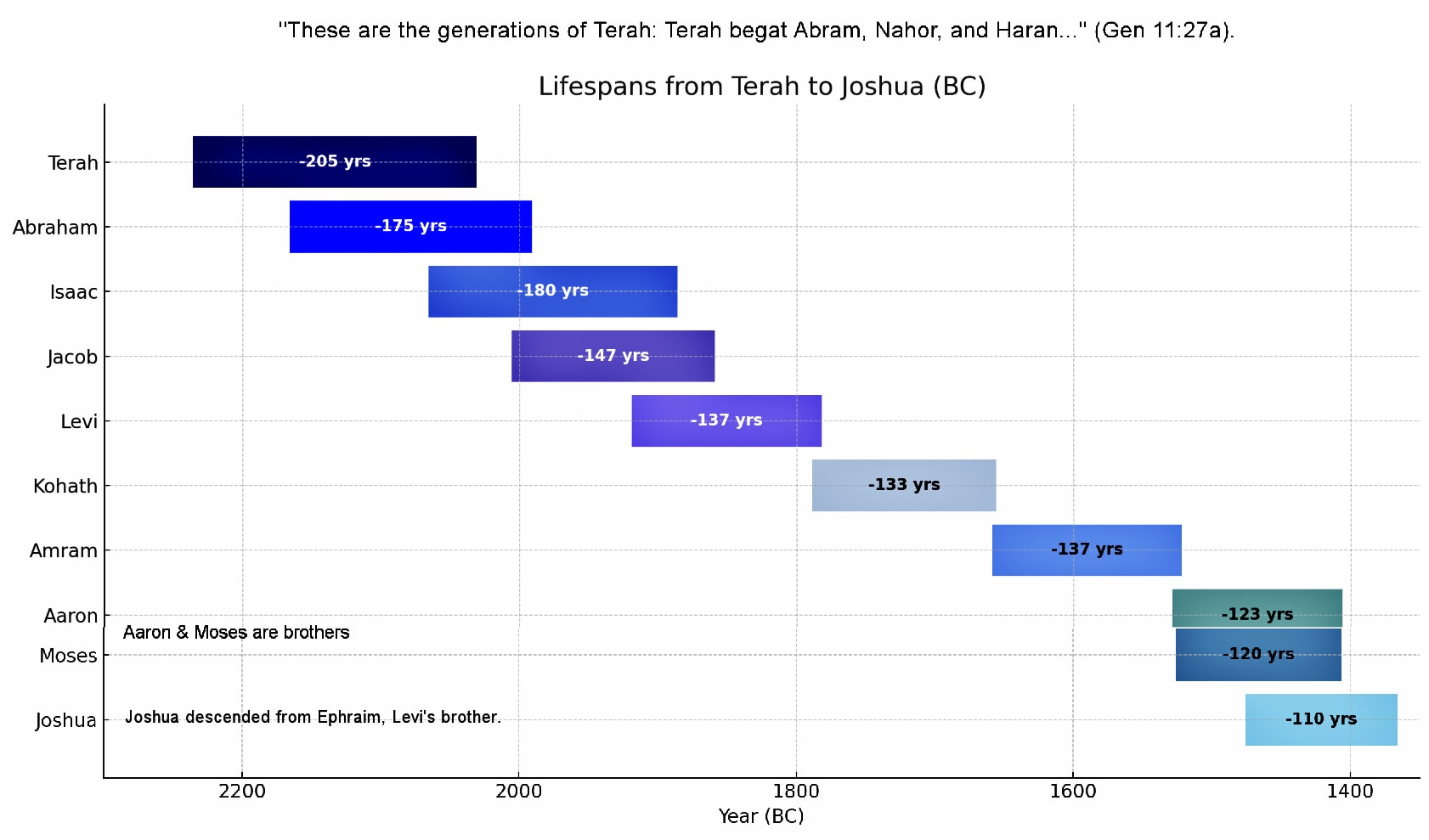
Moses died half a year after Aaron died. Consequently, prior birth and death dates could shift half a year earlier. This establishes 130±3.5 year cycles for figures like Sarah, Joseph, Levi, Kohath, Amram, and Aaron/Moses.
In the Bible, significant individuals typically have both their births and deaths recorded. For those few where this information is missing, it serves two purposes:
- To present a riddle, which the Bible says is an honor to solve.
- To indicate multiple meaningful possibilities for their life spans or dates.
Solving the riddle is like completing a Rubik’s Cube or a jigsaw puzzle. Each number fits precisely, aligning with adjacent elements and the mirrored whole. When all pieces interlock seamlessly, the solution is evident.
“Now these are the generations of Terah: Terah begat Abram, Nahor, and Haran…” (Gen 11:27a).
| Gen. | Name | Birth Year BC | Death Year BC | Lived (Years) |
|---|---|---|---|---|
| — | Terah+60 | 2296 (↓130 to Abraham) | 2091 (↓100 to Abraham) | 205 |
| 1 | Terah | 2236 (↓70) | 2031 (↓40) | 205 |
| 2 | Abraham | 2166 (↓100) | 1991 (↓105) | 175 |
| 3 | Isaac | 2066 (↓60) | 1886 (↓27) | 180 |
| 4 | Jacob | 2006 (↓87) (↓130 to Egypt) | 1859 (↓77) | 147 |
| — | Joseph | 1915 (↓130 to Kohath) | 1805 (↓153 to Kohath) | 110 |
| 5 | Levi | 1919 (↓130/134) | 1782 (↓126/130) | 137 |
| 6 | Kohath | 1789/1785 (↓130/126) | 1656 (↓130 to Moses) /1652 (↓130) | 133 |
| 7 | Amram | 1659 (↓130) | 1522 (↓116) | 137 |
| 8a | Aaron | 1529 (↓130 to ‘Land Rests’) | 1406 | 123 |
| 8b | Moses | 1526 (↓50) | 1406 (↓40) | 120 |
| — | Joshua | 1476 (↓30/70) | 1366 | 110 |
| — | Exodus | 1446 | — | |
| — | Conquest | 1406 | — | |
| — | Land Rests | 1400/1399 | — |
Footnotes:
- Abraham departs Ur: 2091 BC.
- Sarah: 2156-2029 BC, 127 yrs.
- Isaac weds Rebecca 3 yrs post-her demise (Abraham 140 yrs, 130 after Sarah’s birth).
- Jacob’s journey:
- Entered Haran: 1929 BC.
- Weds Leah/Rachel: 1922 BC.
- Returned from Haran: 1909 BC.
- Entered Egypt: 1876 BC.
- Judah: 1918-1789 BC (trad.). Death overlaps Kohath’s birth.
- The 40-year period from Exodus to Conquest symbolizes the 40 days post-birth, marking Israel as God’s firstborn (Ex. 4:22; Lev. 12:1-8).
- Joshua: (1478 or 1476) – (1368 or 1366) BC.
- Miriam, elder sister of Moses & Aaron, died 1 yr pre-Exodus (Num. 20:1). By deduction, she lived 126 yrs (1533-1407 BC). Amram was 126 at her birth, with 7x7x7 yrs in Egypt & born 3.5+3.5 yrs before Aaron & Moses. With SP & LXX variations (-33/-182=-215), Creation is 4114/4081/3899 BC, matching its 3.5+3.5 days/yrs of Creation (& the fall) with 7 & 6.5 times Enochian 364 (& 365) yrs to the 3.5+3.5 of Miriam/Aaron/Moses. Think “Rubik’s Cube!”
The Main Chart of the MT Chronology from Adam to Moses
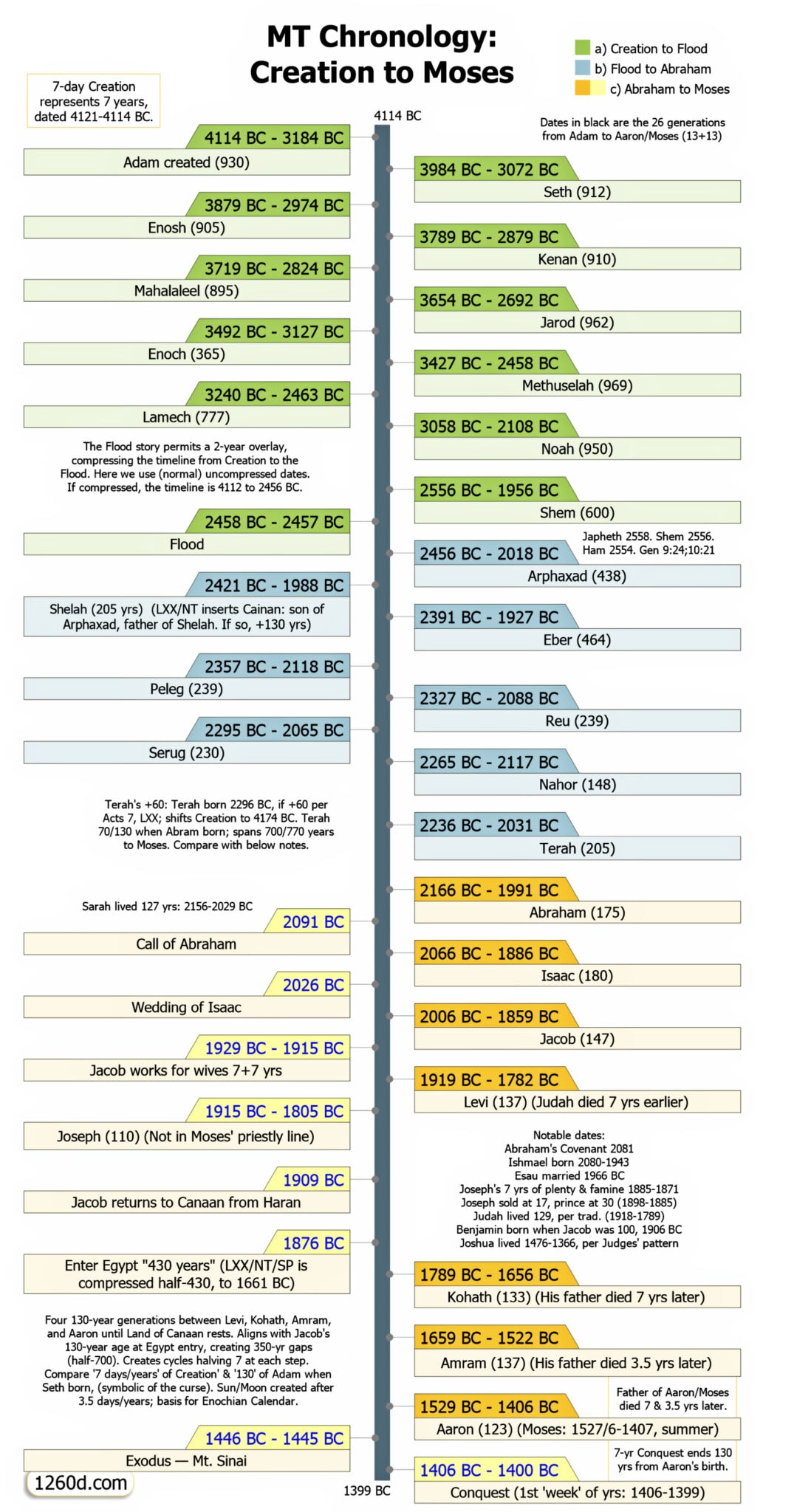
The theological implications of the dates above for Kohath and Amram are extensive. I’ll address these insights in a future discussion, as this article has already exceeded its intended length.
The forthcoming Part Two will delve into the SP and LXX’s accounts of the duration of Israel’s sojourn in Egypt. Stay tuned.

